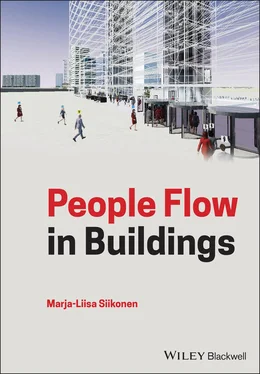The global trend in urbanization in the beginning of the second millennium has seen more and more people moving to cities and the urban environment. According to the Council on Tall Buildings and Urban Habitat (CTBUH 2016) review, there are nearly 45 megacities in the world with the total populations of 10 million people or more. The majority of tall buildings are located in such megacities. In 2018, there were more than 160 completions of buildings taller than 200 m, and 60 of these were taller than 350 m. In the 1990s, about 80% of tall buildings over 200m were located in North America, but now most of them (80%) are in Asia and the Middle East. The number of tall buildings is growing exponentially, being currently about 10 times more than at the turn of the second millennium. The tallest building at the moment is Burj Khalifa in Dubai with height 828m (0.52 miles) and 160 levels. The Kingdom Tower is under construction in Jeddah and it will reach nearly 1000m(0.62 miles) with about 250 levels. Building heights are getting closer to Frank Lloyd Wright’s 1956 vision of the 1 mile (1609 m)‐high building with 528 storeys (Zevi 1991). With the current growth of building heights, this vision may become true in the near future. On the other hand, some countries are considering to limit tall building heights, e.g. to 500 m. However, it yet remains for future generations to see if such a building will ever be built. Without elevators and escalators, the construction of such tall buildings would not be possible. Just as important as elevator technology is the planning of vertical transportation devices to make tall buildings attractive to the owners.
Recent trends forbid people smoking inside the buildings. Buildings are changing to open‐plan offices and office rooms or seats can also be rented to users for some hours or days as in hotels. Working places are designed with flexibility so that the seats can be freely occupied for the time needed, and after becoming free they can be occupied by other people. Possible personal belongings are stored in lockers. Canteens or restaurants can be spread around the building floors, and employees are encouraged to meet each other for a coffee and chat. All these trends cause additional traffic in buildings, which should be considered during elevator planning.
Another trend today is to decrease the ecological footprint of products and design. This reflects in higher energy efficiency of products and utilization of renewable energy sources such as solar, geothermal and wind energy. Attention is paid to the life cycle of products and recycling of components. Waste disposal, e.g. hydraulic lifts with oil, has become rarer. In the 1980‐1990, Variable Voltage Variable Frequency (VVVF) with gearless machineries and permanent magnet technology decreased the elevator machinery size, and energy consumption during the run decreased considerably compared to the earlier relay technology. The daily passenger traffic is related to the running energy consumption of elevators. With motor‐generator sets and Ward Leonard control, energy was no longer pushed to the resistors but could be regenerated to the building or global network, which further saved energy. Running energy has decreased, and the standby energy has increased compared to relay technology. Elevators have started to spend energy to hold cars standing still during a stop when relay elevators used brakes (Jappsen 2018). About 10 years ago, VDI 4707 (VDI 2009) and ISO (ISO 25745‐3 2015) paid attention to elevator energy consumption during standby. Elevator controls started to adopt standby modes where the components were shut down during standby time, and again energy consumption dramatically decreased.
Along with advances in healthcare, the number of middle‐aged people has increased, especially in Europe with an estimated 80 million elderly and disabled people. For elderly people, accessibility in and out of buildings has become important, but the same is true of young families with children. After the collapse of the World Trade Center in New York during 9/11, debate began on the evacuation of people from tall buildings. Consequently, there has been a broad impact on building and elevator design, and elevator planning. The International Building Code, IBC, of the United States, depending on the building occupancy and height, now requires either three exit stairs, or two exit stairs supplemented by occupant evacuation elevators, OEEs. According to the European Union directives 98/34/EC and 98/48/EC, an elevator for disabled people is required for every new building with more than three floors, which is adopted in local building codes. The European codes requires accessibility of passengers in and out of buildings (EN 81‐70 2018), and evacuation of disabled people with elevators (ISO TS 8101‐1 2020). Down‐peak and building evacuation for non‐fire and fire situations are adopted in the elevator planning and design of tall buildings.
This book explains how modern trends in building usage affect the people‐flow planning in buildings. Elevator planning for tall office buildings has by far mostly been based on uppeak traffic calculation. In addition to up‐peak, down‐peak and mixed lunch hour traffic peaks have become important factors in determining transportation devices in building design. Important in traffic planning is to compare different results. This is possible only if the traffic terms have common definitions. The book has gathered definitions to the traffic terms from the ISO standards, published traffic books, the Chartered Institution of Building Services Engineers, CIBSE, planning guides and articles in this order. Also, some new traffic terms are introduced.
The ongoing world‐wide Covid‐19 pandemic is currently raging all over the world. The virus infection spreads through airborne exposure and breath, and therefore people need to avoid social contacts. It has created a ‘new normal’ way for people to cope with the virus, which has widespread effects in all fields in the society‐life, e.g. working surroundings, travelling and cultural life. The future will show what kind of requirements the pandemic will set for the building industry and elevators to provide residents safe and healthy environment to live and work.
The book starts with the definitions of terms and symbols, and continues with five parts dealing with measurement, control, modelling and planning of people flow in buildings. Each part begins with an introduction describing the contents and the background of the item. In the appendices, measured passenger data and performed analysis results are added. The first part concentrates on measured people flow in buildings. Firstly, the method to define population in different types of buildings is explained. Secondly, passenger counting methods introduced in buildings and elevator lobbies are considered. The arrival process was studied more than 40 years ago by Alexandris (1977) who showed that in office buildings during morning up‐peak the passenger arrivals followed a Poisson process. The latest passenger counting measurements have shown that individual passenger arrivals can follow a Poisson process in the morning up‐peak. More often during the day, however, arrivals of passenger batches followa Poisson process. This conclusion is based on measured passenger arrivals in offices, hotels and residential buildings. Thirdly, daily passenger traffic profiles in different types of buildings are shown. Most of the measurements were made by elevator control system that counted the passengers using a load‐weighing device below the car floor and photocell signals in the car door opening. The measured profiles are compared to the profiles introduced by Strakosch already in 1967 (Strakosch 1983). Finally, elevator service level and performance statistics monitored from real buildings are shown. They include passenger waiting times, call times, number of calls and elevator starts.
Читать дальше












